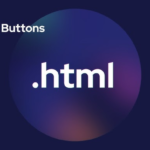Are you ready to build stunning websites from scratch? This beginner-friendly guide will teach you the basics of HTML (HyperText Markup Language)—the foundation of web development. By the end of this blog, you’ll understand how to create well-structured, responsive, and professional web pages using just HTML.

What is HTML?
HTML (HyperText Markup Language) is the standard language used to create web pages. It defines the structure and content of a website, using elements like headings, paragraphs, links, and images.
Why is HTML Important?
- It’s the foundation of every website.
- HTML works with CSS for styling and JavaScript for interactivity.
- It’s easy to learn and beginner-friendly.

Getting Started with HTML
1. Setting Up Your First HTML File
Tools You’ll Need:
- A text editor like Notepad++ or Visual Studio Code.
- A web browser like Google Chrome or Firefox.
Save Your File:
Create a new file and save it with the extension .html (e.g., index.html).
2. Basic HTML Structure

Here’s the basic structure of an HTML document:
<!DOCTYPE html>
<html lang="en">
<head>
<meta charset="UTF-8">
<meta name="viewport" content="width=device-width, initial-scale=1.0">
<title>My First Website</title>
</head>
<body>
<h1>Hello, World!</h1>
<p>This is my first webpage using HTML.</p>
</body>
</html>
Explanation of Code:
<!DOCTYPE html>– Declares the document as HTML5.<html>– The root element that wraps all code.<head>– Contains metadata like title and character encoding.<title>– Displays the page title in the browser tab.<body>– Contains the visible content of the webpage.

HTML Elements and Tags
1. Headings
Use headings to define titles and subtitles.
<h1>Main Heading</h1>
<h2>Subheading</h2>
<h3>Sub-subheading</h3>
Tip: Always use <h1> for the main title and <h2> to <h6> for subheadings to maintain SEO hierarchy.
2. Paragraphs and Text Formatting
Add paragraphs and format text easily:
<p>This is a paragraph.</p>
<b>Bold Text</b>
<i>Italic Text</i>
<u>Underlined Text</u>
3. Links (Hyperlinks)
Create clickable links to navigate between pages or external sites.
<a href="https://www.example.com">Visit Example</a>
Open in New Tab:

<a href="https://www.example.com" target="_blank">Open in New Tab</a>
4. Images
Add images to your web page:
<img src="image.jpg" alt="A beautiful landscape">
src: Specifies the image path or URL.alt: Provides alternative text for accessibility and SEO.
5. Lists
Unordered List (Bullets):
<ul>
<li>Item 1</li>
<li>Item 2</li>
</ul>
Ordered List (Numbers):
<ol>
<li>Step 1</li>
<li>Step 2</li>
</ol>
6. Tables
Create structured data using tables:
<table border="1">
<tr>
<th>Name</th>
<th>Age</th>
</tr>
<tr>
<td>John</td>
<td>25</td>
</tr>
</table>
Tags Used:
<table>– Creates the table.<tr>– Adds rows.<th>– Defines header cells.<td>– Defines data cells.
7. Forms

Gather user input with forms:
<form action="submit.php" method="post">
<label for="name">Name:</label>
<input type="text" id="name" name="name">
<input type="submit" value="Submit">
</form>
8. Div and Span Tags
Div: Groups elements for styling or layout.

<div>
<h2>Title</h2>
<p>Content inside a div.</p>
</div>
Span: Styles inline text or elements.
<p>This is a <span style="color: red;">highlighted</span> word.</p>
SEO Optimization with HTML
- Meta Tags for SEO:

<meta name="description" content="Learn HTML to build stunning websites from scratch. Beginner-friendly guide to web development.">
<meta name="keywords" content="HTML, Web Development, Build Websites, Learn HTML">
- Image Optimization: Use alt text for images to improve accessibility and SEO.
<img src="image.jpg" alt="HTML coding example">
- Header Tags: Maintain proper heading hierarchy using
<h1>to<h6>. - Mobile Responsiveness:

<meta name="viewport" content="width=device-width, initial-scale=1.0">
FAQs About HTML
1. Is HTML hard to learn?
No, HTML is one of the easiest programming languages to learn, even for beginners.
2. How long does it take to learn HTML?
You can learn the basics in 1–2 weeks, but practice is key to mastering it.
3. Can I create a full website using just HTML?
HTML provides the structure, but for design and interactivity, you’ll need CSS and JavaScript.
Final Thoughts
HTML is the foundation of web development. By mastering its basics, you can create visually appealing and well-structured websites. Start experimenting with headings, images, and forms today to bring your ideas to life!
Ready to build your first website? Dive into HTML coding now and unlock endless possibilities in web development!
Meta Description:
Learn how to build stunning websites from scratch using HTML. This beginner-friendly guide explains HTML basics, tags, forms, tables, and SEO optimization tips.
Focus Keywords:
HTML tutorial, build websites from scratch, HTML basics for beginners, web development guide, HTML coding tips, learn HTML.
